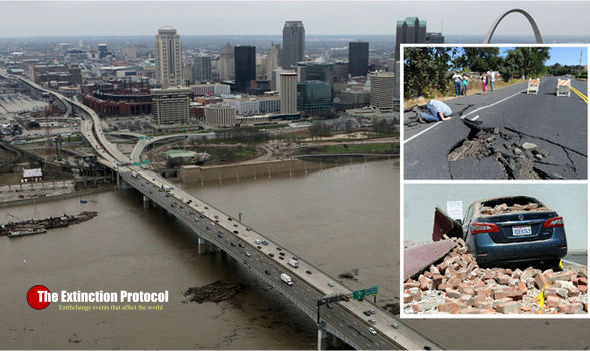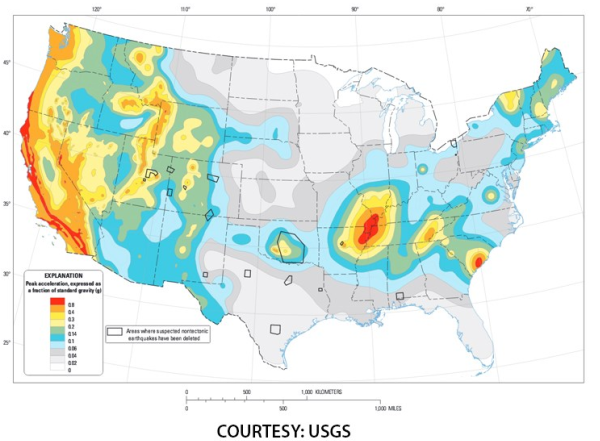Central U.S. preparing for mega earthquake

June 2016 – SIKESTON, Missouri – It
is well known that California and most of the west coast of the USA are
thought to be long overdue magnitude 7 or stronger earthquakes. News
there has been significant movement along the 800-mile San Andreas Fault
in the Sunshine State and an emergency drill of how to deal with a
devastating tsunami along the length of the west coast, have kept both
impending natural disasters in the headlines across the globe.
But it has largely been forgotten that
another potential disaster is lurking within the ground in Missouri. The
150-mile long New Madrid Seismic Zone in New Madrid, Missouri, is the
source of the concern, and is also thought to be overdue for a massive
tremor, which would impact seven states – Illinois, Indiana, Missouri,
Arkansas, Kentucky, Tennessee and Mississippi. It has not seen
significant earthquakes for more than 200 years.
In the winter of 1811 and 1812 there
were three earthquakes of magnitude 7 – as high as 7.7 – and a series of
aftershocks across the American Midwest. The results were catastrophic,
with the course of the Mississippi being diverted, chasms ripping open,
and volcanoes of sand and water bursting through the ground. The
Federal Emergency Management Agency (FEMA) warned in 1999 there were
four natural disasters which threatened the states.
They included major hurricanes hitting
Miami and New Orleans, which has recently been rocked by Katrina, and
megaquakes hitting Los Angeles, and the central USA. The US Geological
Survey (USGS) has a map of the country which includes a giant pink
warning area over the central states. Each year there are hundreds of
small tremors in the New Madrid Seismic Zone, including a 3.5 magnitude
quake last month, which many saw as a precursor. The USGS even raised
the threat level for 2016 after this increase in activity. Although the
risk to these areas is less trumpeted than California and the west
coast, $260million was spent on seismic strengthening of the I-40 bridge
over the Mississippi into Memphis.
It is hoped the crossing, which towers
over the river, could now withstand the anticipated shocks. Memphis
state officials also reduced the main hospital by nine floors to limit
the risk of collapse at a cost of $64m. The Mid-America Earthquake
Center at the University of Illinois released a report in 2009, which
suggested the effects of a force seven or stronger quake from the fault
line. Amr Elnashai, the study’s lead author, wrote “All hell will break
loose.”
The predicted scenario saw close to
715,000 buildings, including 130 hospitals, and 3,500 bridges damaged.
Deaths and injuries were estimated at 86,000 with a combined loss of
$300billion. The Central US Earthquake Consortium (CUSEC) is based next
to Memphis Airport. James Wilkinson, its director, fears the Mississippi
would be released from an engineered prison of levees, causing maximum
damage. He told The Atlantic: “The thing that, to me, makes the
river scary is how much industry we have along it: there’s power
plants, there’s chemical plants, there’s ports. “And the river might
change course altogether.

“I mean if we’re at flood stage, it’s
kind of the worst-of-the-worst case scenario. “So if the levees are
already jeopardised either by overtopping or saturation, where the
water’s been there for quite a while, and then you get a shake to it?
“You know, the river’s just gonna take the path of least resistance. And
who knows whether that’s right through these communities.
“I doubt it’s going to stay in the
channel it’s in. The Army Corps of Engineers battles that on a daily
basis but the river’s already trying to change course. “They keep it
somewhat channeled, but in a massive earthquake we could lose a good
part of Western Kentucky, we could lose a good part of Arkansas or
southern Missouri.”
He is convinced it is only a matter of
time. He said: “We’ve had earthquakes, we’ve had damage, but nothing
like what we’ve seen in other parts of the world. So the clock’s
ticking.” But not all seismologists agree. Seth Stein, based in
Evanston, Illinois, has researched the fault line for 30 years, and told
The Atlantic the warnings were “dangerous nonsense.” He set up GPS
receivers along the fault line and found the land was moving two
millimeters a year, if at all, meaning there is next to no strain within
it. He said: “Basically the way to think about the lithosphere – and
it’s easy when you live in Chicago – is, imagine you have big chunks of
ice floating around on the lake, and those things are sliding by each
other.
So those are the plate boundary
earthquakes, like in California. “But then within those big ice sheets
you have small cracks. And there are very small motions within them.
That’s how the big pieces stay together.” He claims Stein any recorded
new rumblings are still the aftershocks of the 1811-1812 events. He
added: “Every time there’s a magnitude 4 people like CUSEC are claiming
giant earthquake’s on the way. And you think about this, and you look
into the rock physics and it says no, it’s the opposite. Those are
aftershocks.” –Express


Nessun commento:
Posta un commento